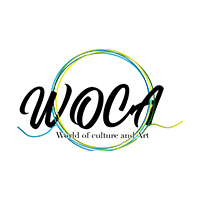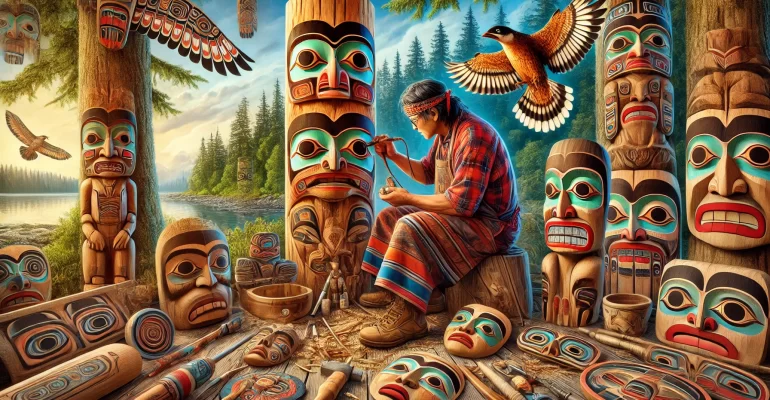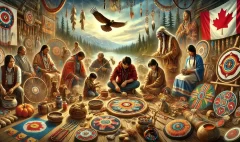Shaping Traditions: The Art of Indigenous Woodworking and Carving in Canada
Shaping Traditions: The Art of Indigenous Woodworking and Carving in Canada
Welcome to the fascinating world of Indigenous woodworking and carving in Canada! This ancient art form has been a cornerstone of Indigenous cultures for thousands of years, telling stories, preserving history, and showcasing the incredible skill of Indigenous artisans. In this exploration, we’ll delve into the rich traditions, techniques, and significance of woodworking and carving across various Indigenous nations in Canada.
The Roots of Indigenous Woodworking and Carving
Indigenous woodworking and carving in Canada have deep roots that stretch back millennia. These art forms have evolved alongside the diverse cultures of First Nations, Inuit, and Métis peoples, reflecting their unique relationships with the land, their spiritual beliefs, and their cultural narratives. Historically, woodworking and carving served multiple purposes in Indigenous communities:
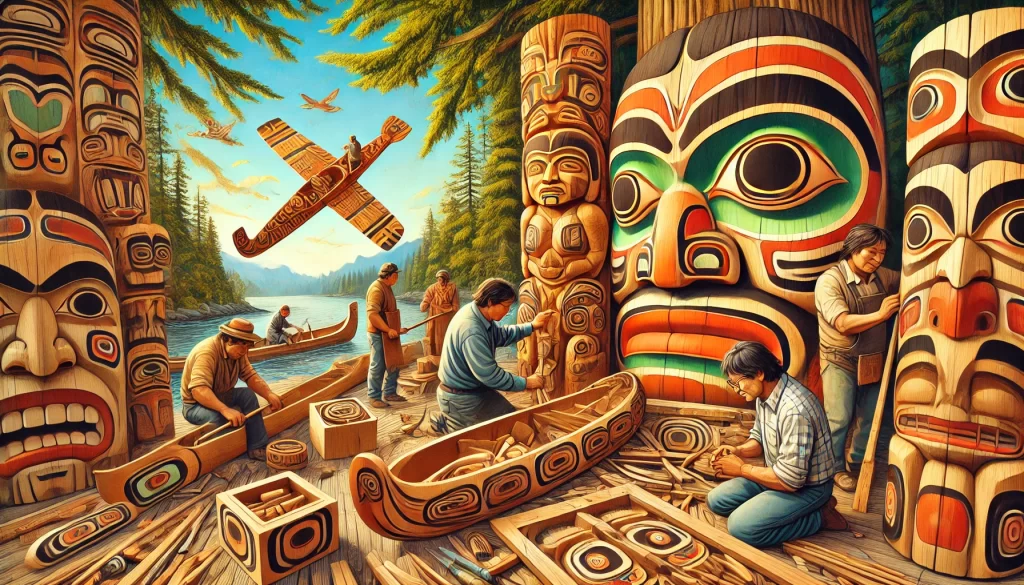
- Spiritual and Ceremonial: Many carved objects played crucial roles in religious and spiritual practices.
- Functional: Carved items were often practical tools used in daily life.
- Storytelling: Carvings frequently depicted legends, histories, and important cultural teachings.
- Social and Political: Some carved objects, like totem poles, conveyed information about family lineages and social status.
The materials used in these arts were typically sourced from the local environment, creating a deep connection between the art, the artist, and the land. Different regions of Canada provided different types of wood, each with its own unique properties and spiritual significance.
Regional Diversity in Woodworking and Carving
Across Canada, Indigenous woodworking and carving traditions vary greatly, reflecting the diversity of Indigenous cultures and their environments.
- West Coast
The Pacific Northwest Coast is renowned for its distinctive woodcarving traditions. Nations in this region, including the Haida, Kwakwaka’wakw, Coast Salish, and Tlingit, are famous for their:
– Totem Poles: Massive carved poles that tell family or clan histories, commemorate important events, or serve as memorials.
– Masks: Intricate face masks used in ceremonial dances and storytelling.
– Bentwood Boxes: Steam-bent wooden boxes, often decorated with carved or painted designs.
– Canoes: Large dugout canoes carved from single cedar logs.
The style of West Coast carving is characterized by bold, stylized forms and the use of formline design – a system of shapes and lines that create complex, interconnected patterns.
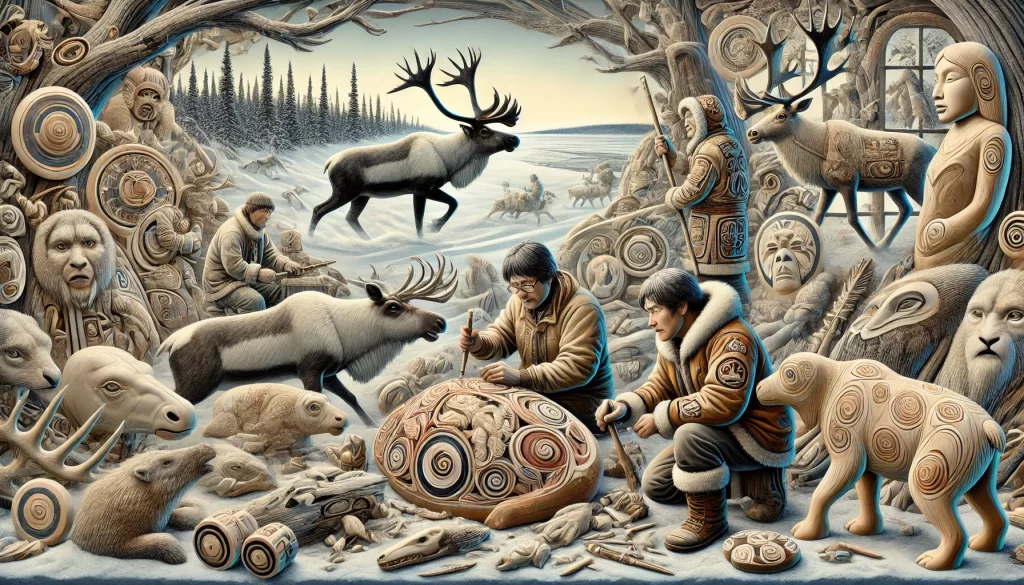
- Arctic and Subarctic
In the far north, Inuit and some First Nations carving traditions have adapted to the unique materials available in treeless landscapes:
– Soapstone Carving: While not woodworking, this important carving tradition uses soft stone to create sculptures.
– Antler and Ivory Carving: Using materials from marine mammals and caribou.
– Driftwood Carving: In areas where wood is scarce, driftwood becomes a precious resource for carving.
Inuit carvings often depict animals, hunting scenes, and spiritual beings, with a style that ranges from naturalistic to highly stylized.
- Eastern Woodlands
Nations in the eastern forests of Canada, such as the Haudenosaunee (Iroquois), Anishinaabe, and Mi’kmaq, have their own woodworking and carving traditions:
– False Face Masks: Used in healing ceremonies by some Haudenosaunee nations.
– Birchbark Canoes: Lightweight vessels made by stretching birchbark over a wooden frame.
– Wooden Rattles and Drums: Important in ceremonial and musical traditions.
Eastern Woodland carvings often feature more curvilinear designs compared to the geometric styles of the West Coast.
- Plains
While Plains cultures are more commonly associated with hide work and beading, woodcarving also plays a role:
– Ceremonial Pipes: Often featuring carved wooden stems.
– Decorated Clubs and Staffs: Used in ceremonies and as symbols of authority.
Plains carvings tend to be more minimalist in style, often incorporating painted designs alongside carved elements.
Techniques and Tools in Indigenous Woodworking and Carving
The techniques used in Indigenous woodworking and carving have been refined over thousands of years, passing from generation to generation. While methods can vary between nations and individual artists, some common techniques include:
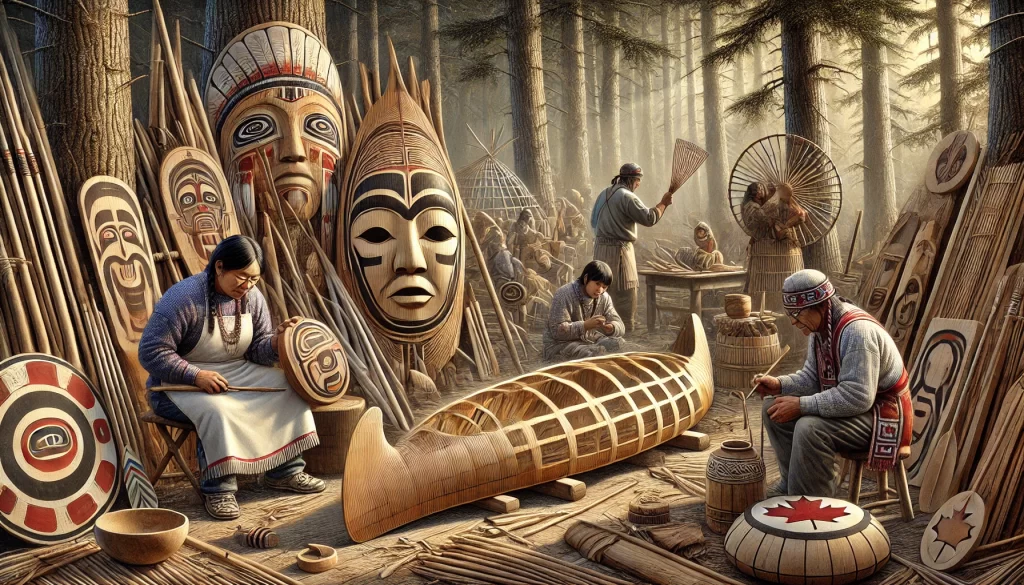
- Adzing: Using an adze (a tool similar to an axe but with the blade perpendicular to the handle) to rough out the basic shape of a carving.
- Carving: Using various knives and chisels to create detailed designs and textures.
- Steaming and Bending: A technique used particularly in West Coast traditions to create bentwood boxes and canoes.
- Joining: Methods of connecting pieces of wood, often using natural materials like cedar withes or sinew.
- Smoothing and Finishing: Using tools like sandstone or sharkskin to smooth surfaces, followed by oiling or painting.
Traditional tools were often made by the carvers themselves, using materials like stone, bone, antler, and eventually metal. Today, many carvers use a combination of traditional and modern tools, adapting their techniques while maintaining the spirit of their ancestral practices.
Symbolism and Meaning in Indigenous Carvings
Indigenous woodcarvings are rich with symbolism, often conveying complex cultural narratives and spiritual beliefs. While meanings can vary significantly between nations and even individual artists, some common symbolic elements include:
– Animal Figures: Often representing clan totems, spirit helpers, or teaching stories.
– Human Figures: May depict ancestors, mythological beings, or historical figures.
– Natural Elements: Sun, moon, mountains, and water are frequently represented, often with spiritual significance.
– Geometric Patterns: Can represent concepts like balance, the four directions, or the connection between the physical and spiritual worlds.
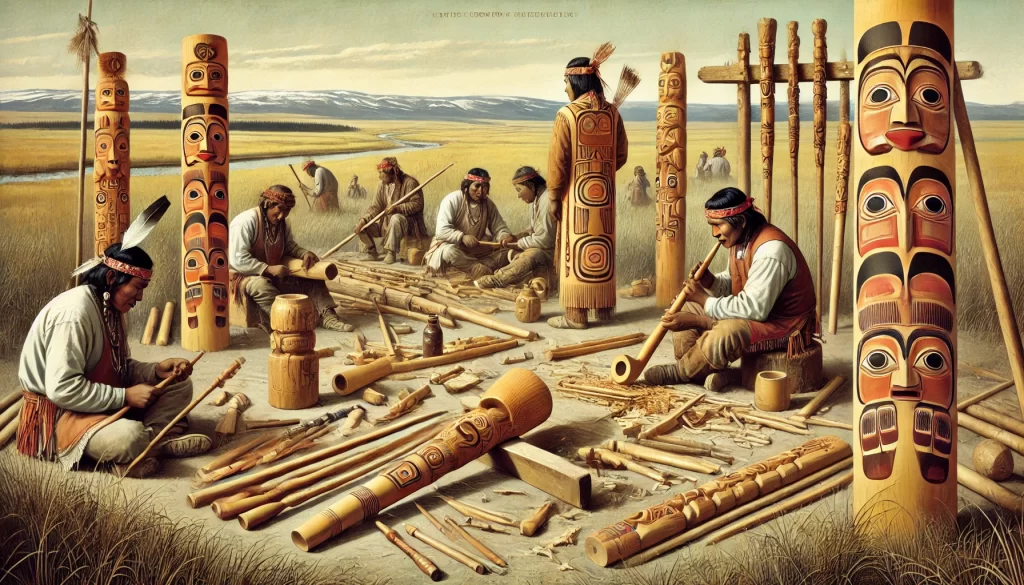
Understanding these symbols requires deep knowledge of the specific culture they come from. What might appear as a simple design to an outsider often carries layers of meaning for those within the culture.
The Role of Woodworking and Carving in Indigenous Cultures
Woodworking and carving play vital roles in many aspects of Indigenous cultures:
- Cultural Preservation: Carvings serve as physical representations of oral histories and traditions.
- Spiritual Practice: Many carved objects are integral to ceremonies and spiritual rituals.
- Economic Sustainability: The sale of carvings provides income for many Indigenous artists and communities.
- Education: The process of learning to carve is often a way of passing down cultural knowledge and values.
- Identity and Pride: Carved objects serve as powerful symbols of cultural identity and resilience.
- Healing and Wellness: For many Indigenous people, the act of carving itself is a form of cultural healing and connection.
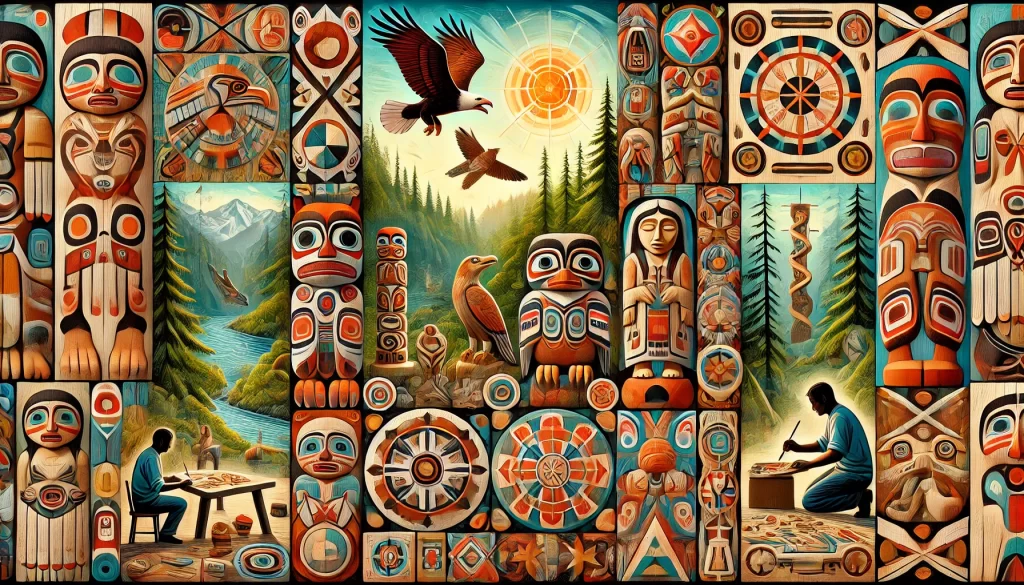
Contemporary Indigenous Woodworking and Carving
While deeply rooted in tradition, Indigenous woodworking and carving are living art forms that continue to evolve. Contemporary Indigenous carvers are finding new ways to express their cultural heritage:
– Blending Traditions: Some artists incorporate elements from multiple Indigenous traditions or blend Indigenous and non-Indigenous styles.
– New Materials: While traditional materials remain important, some artists experiment with new media, including metals and synthetic materials.
– Contemporary Themes: Many carvers address modern issues in their work, such as environmental concerns or the impacts of colonization.
– Public Art: Large-scale Indigenous carvings are increasingly featured in public spaces, bringing these art forms to wider audiences.
– Digital Technology: Some artists are using digital design tools to plan their carvings or create digital renderings of traditional designs.
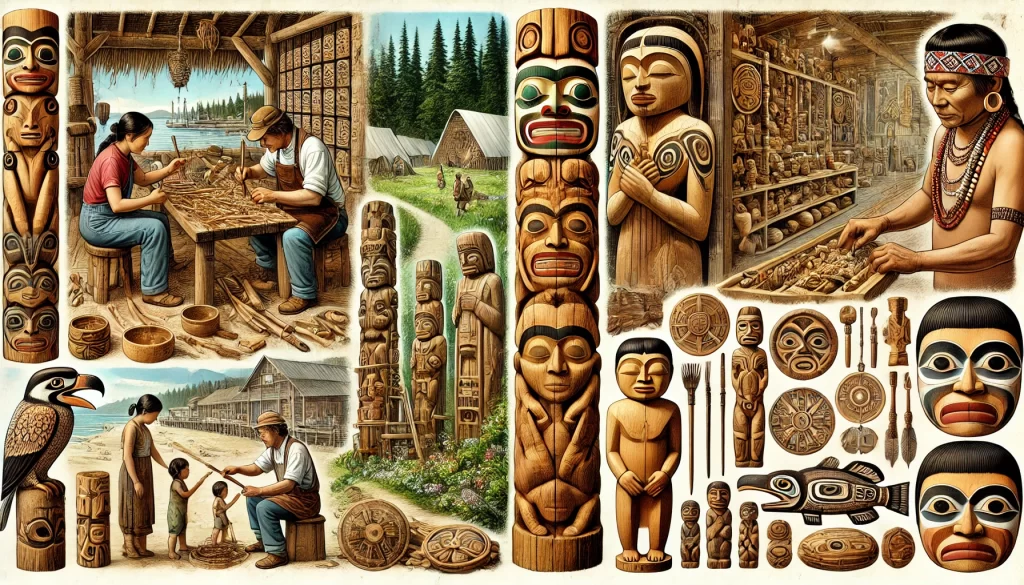
Challenges and Preservation Efforts of Indigenous Woodworking and Carving
Indigenous woodworking and carving traditions face several challenges:
- Loss of Traditional Knowledge: The disruption of cultural transmission due to historical policies like residential schools has impacted the passing down of carving skills.
- Access to Materials: Environmental changes and land access issues can make it difficult to obtain traditional carving materials.
- Market Pressures: The demand for “authentic” Indigenous art can sometimes lead to mass-produced imitations that undervalue the work of skilled Indigenous carvers.
- Cultural Appropriation: Non-Indigenous reproduction of Indigenous designs can dilute their cultural significance and impact Indigenous artists’ livelihoods.
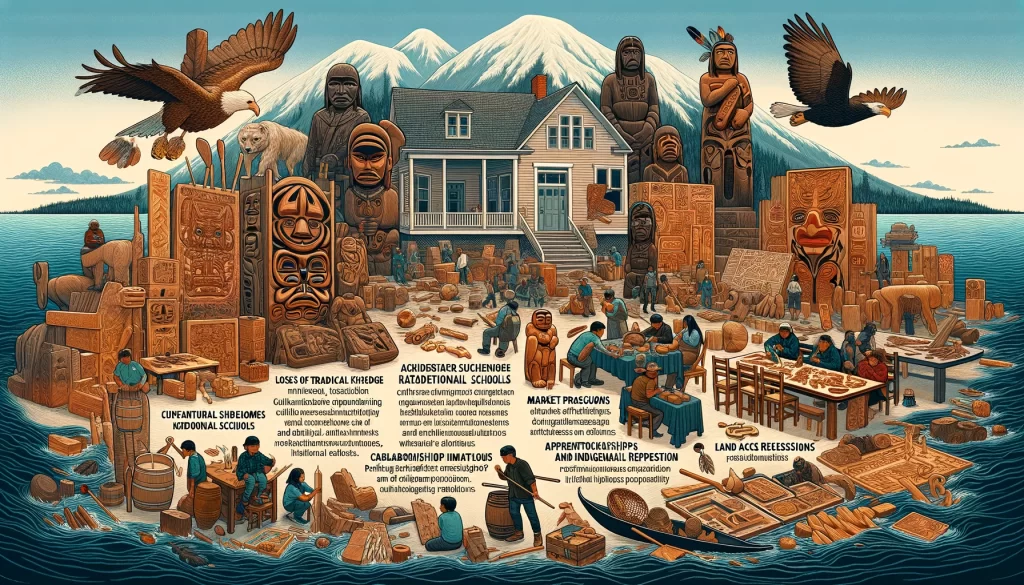
However, there are also many efforts underway to preserve and revitalize these traditions:
– Cultural Centers: Many Indigenous communities have established cultural centers where traditional arts, including carving, are taught and practiced.
– Apprenticeship Programs: Initiatives that pair young Indigenous people with master carvers to learn traditional techniques.
– Museum Partnerships: Collaborations between Indigenous communities and museums to properly care for and interpret historical carvings.
– Legal Protections: Efforts to protect Indigenous intellectual property rights and combat the sale of inauthentic “Indigenous-style” art.
WOCA Group’s Commitment to Indigenous Woodworking and Carving
At WOCA Group, we recognize the immense cultural value of Indigenous woodworking and carving traditions. We are committed to supporting and promoting these art forms in several ways:
- Educational Workshops: We host workshops led by Indigenous master carvers, offering community members the opportunity to learn about these traditions firsthand.
- Exhibition Space: Our community center features a dedicated gallery space for displaying the work of local Indigenous woodworkers and carvers.
- Artist-in-Residence Program: We sponsor Indigenous artists to work in our community, creating public art pieces and engaging with local residents.
- Youth Mentorship: We facilitate connections between Indigenous youth and experienced carvers to encourage the continuation of these traditions.
- Advocacy: We work to raise awareness about the importance of supporting authentic Indigenous art and the issues facing Indigenous artists.
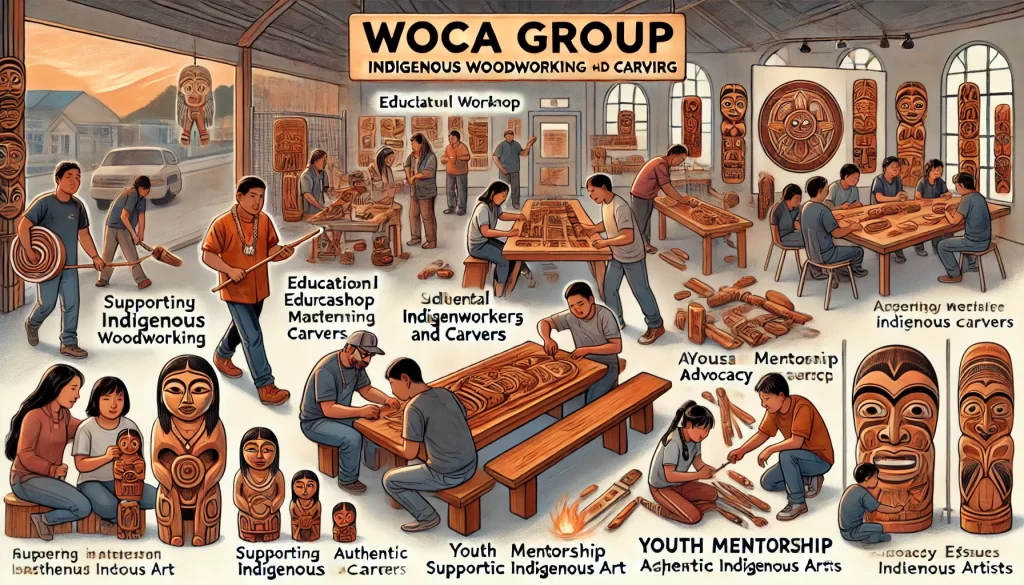
Appreciating Indigenous Woodworking and Carving
For those interested in Indigenous woodworking and carving, there are many ways to appreciate and support these art forms respectfully:
- Learn: Take time to understand the cultural context and significance of Indigenous carvings.
- Visit: Explore museums and cultural centers that properly display and interpret Indigenous art.
- Support: Purchase authentic Indigenous art directly from artists or reputable galleries that fairly compensate Indigenous creators.
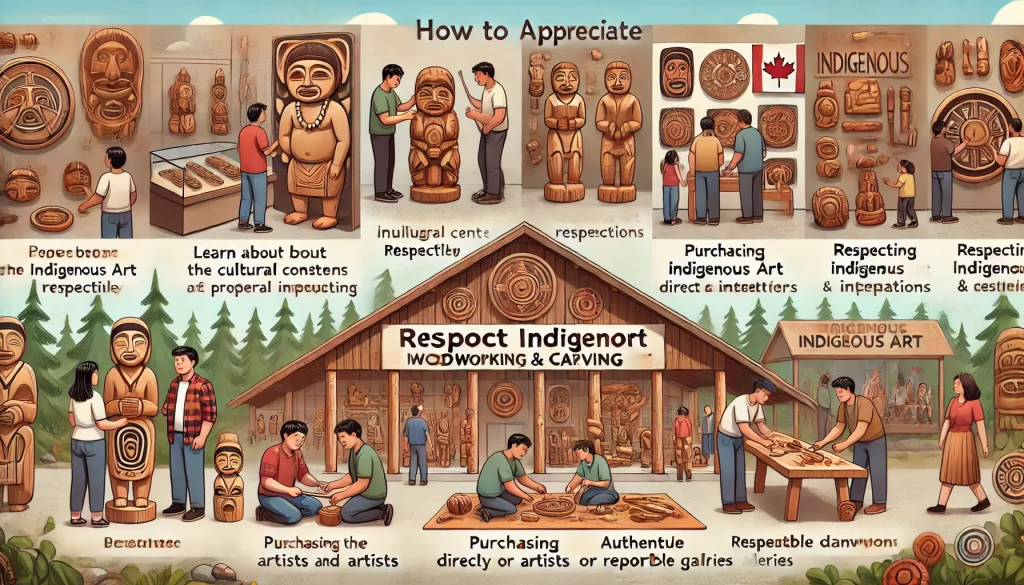
- Respect: Recognize that some designs and symbols have deep cultural significance and may not be appropriate for reproduction or personal use.
- Engage: Attend Indigenous art events, such as carving demonstrations or artist talks, to learn directly from Indigenous creators.
Conclusion: The Living Legacy of Indigenous Woodworking and Carving
Indigenous woodworking and carving in Canada represent far more than just artistic techniques. They are living traditions that connect past, present, and future generations, embodying cultural knowledge, spiritual beliefs, and the enduring creativity of Indigenous peoples. From the towering totem poles of the West Coast to the delicate birchbark crafts of the Eastern Woodlands, these art forms showcase the incredible diversity and skill of Indigenous cultures across Canada. As we appreciate the beauty and complexity of Indigenous carvings, we are invited to deepen our understanding of the rich cultural heritage they represent.
By supporting Indigenous woodworkers and carvers, learning about their traditions, and respecting the cultural significance of their work, we can all play a part in ensuring that these vital art forms continue to thrive for generations to come. The story of Indigenous woodworking and carving in Canada is far from over – it is a living, growing legacy that continues to shape the cultural landscape of our nation.
